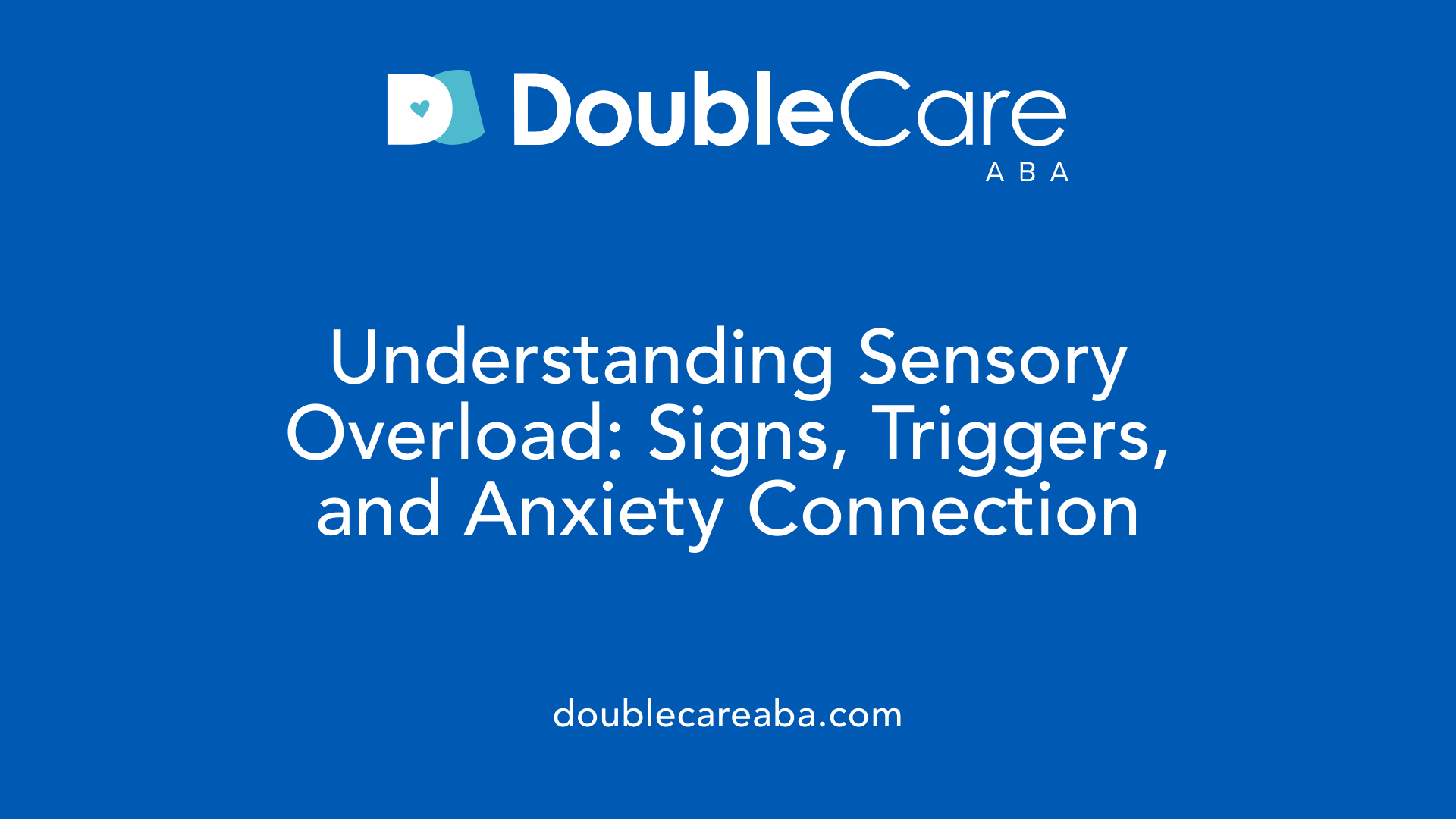Autism and Strategies for Calming Anxiety in Crowded Spaces
Practical Approaches to Managing Autism-Related Anxiety in Busy Environments

Understanding Anxiety and Sensory Challenges in Autism
Navigating crowded spaces can be deeply stressful for individuals with autism, frequently triggering anxiety and sensory overload. This article explores the roots of these challenges and provides actionable strategies tailored to help autistic individuals and their caregivers manage anxiety in busy public settings effectively.
Recognizing Sensory Overload and Its Impact on Anxiety

What is sensory overload?
Sensory overload occurs when an autistic individual's senses are bombarded with more input than they can process, leading to overwhelm. This excessive stimulation causes physical discomfort and emotional distress.
What common sensory triggers cause overload?
Triggers often involve bright lights, loud noises, specific textures, and strong smells. Each person's sensitivities vary, but these are frequent sources of sensory stress in both home and public environments.
What are the physical and behavioral signs of overstimulation?
Signs include irritability, anxiety, and self-soothing behaviors such as rocking or hand-flapping. Covering the ears or eyes, pacing, and withdrawal are also indicators. Physically, individuals may experience head pain, nausea, or muscle tension during overload.
How do sensory sensitivities relate to anxiety?
Sensory sensitivities can directly trigger anxiety, as the overwhelm causes avoidance behaviors and heightens emotional distress. For many autistic individuals, difficulty expressing discomfort adds to feelings of being misunderstood, exacerbating anxiety. Moreover, unpredictable environments and changes can intensify these responses, making early recognition and support vital for managing anxiety linked to sensory overload.
Differentiating Between Meltdowns and Tantrums

What Causes Autistic Meltdowns?
Autistic meltdowns are intense responses triggered by sensory and emotional overload. They occur when an individual becomes overwhelmed by stimuli such as bright lights, loud noises, or strong smells. Other common triggers include disruptions to routine, frustration, anxiety, or exhaustion. Importantly, meltdowns are not deliberate misbehavior but automatic reactions to overwhelm.
Recognizing Early Warning Signs of Overstimulation
Before a meltdown occurs, there are often early signals indicating that an individual is becoming overstimulated. These signs can include pacing, rocking back and forth, covering ears, asking repeated questions, withdrawing from interactions, or trying to hide. Recognizing these early behaviors allows caregivers to intervene and help prevent the meltdown.
How Meltdowns Differ from Tantrums
Meltdowns differ significantly from tantrums, primarily in intent and control. Tantrums are typically intentional, goal-oriented behaviors where a child seeks attention or to manipulate a situation. In contrast, meltdowns are uncontrollable responses where the individual is overwhelmed and unable to regulate their emotions or behavior. They reflect a need for support rather than punishment.
This understanding is crucial for providing empathetic and effective support. Knowing that meltdowns stem from sensory and emotional overload, rather than willful defiance, helps caregivers and educators respond with patience and appropriate strategies.
Applied Behavior Analysis (ABA) Therapy: Fundamentals and Uses

What is Applied Behavior Analysis (ABA) therapy and how is it used to help individuals with autism?
Applied Behavior Analysis (ABA) therapy is a science-based approach that focuses on improving social, communication, and learning skills in individuals with autism. It uses principles of learning and motivation to understand and modify behaviors, aiming to increase helpful behaviors while reducing harmful or challenging ones.
ABA therapy involves analyzing the reasons behind behaviors and then applying methods such as positive reinforcement, prompting, and task analysis. Common techniques include Discrete Trial Training (structured teaching of skills), Pivotal Response Treatment (targeting motivation and response to multiple cues), and naturalistic teaching strategies that occur in everyday environments. Progress is regularly monitored through data collection, allowing therapists to adjust goals and methods based on individual needs.
How does ABA support individuals with autism?
ABA supports autistic individuals by teaching functional skills that improve communication, social interaction, and emotional regulation. This can include learning how to express needs, manage anxiety, tolerate sensory input, and develop independence in daily activities. Early intervention with ABA therapy can lead to significant improvements in language, cognition, and overall functioning.
Additionally, ABA incorporates techniques to manage behaviors that may be linked to sensory overload or anxiety, helping children cope with challenging environments such as public spaces or social situations.
In what settings is ABA therapy delivered?
ABA therapy is versatile and can be provided in multiple settings to best suit the individual's lifestyle and needs. These settings include:
- Home: Personalized one-on-one sessions with therapists and caregiver involvement.
- School: Integration within the classroom to support academic and social skills.
- Community: Real-world practice in environments like parks or stores, often through structured community events.
Training parents and caregivers is also a core component, ensuring skills learned in therapy generalize to other environments.
Through its structured, data-driven approach, ABA therapy remains a widely recognized and effective intervention for individuals with autism, tailored to foster meaningful progress across various life domains.
Professional Qualifications of ABA Therapy Providers

Who provides ABA therapy and what qualifications do professionals in this field typically have?
ABA therapy is delivered by a specialized team including Board Certified Behavior Analysts (BCBAs), Board Certified Assistant Behavior Analysts (BCaBAs), and Registered Behavior Technicians (RBTs). Each plays a distinct role in supporting individuals with autism through behavioral interventions.
Roles of BCBAs, BCaBAs, and RBTs
- BCBAs: They are responsible for designing and overseeing individualized treatment plans. Their role includes conducting behavioral assessments, supervising therapy delivery, and adapting interventions to meet evolving needs.
- BCaBAs: Acting as assistants to BCBAs, BCaBAs support therapy planning and supervise RBTs during implementation, ensuring continuity and adherence to treatment protocols.
- RBTs: These professionals provide direct therapy to clients and gather critical data on behavior. Their hands-on work is vital to applying strategies prescribed by certified analysts.
Education and Certification Requirements
- BCBAs and BCaBAs: Both require advanced academic qualifications related to behavior analysis. Candidates must complete supervised fieldwork placements and pass rigorous certification exams administered by the Behavior Analyst Certification Board (BACB).
- RBTs: Typically, RBTs need a high school diploma, complete a formal training program, and successfully pass a certification exam to validate their skills.
Team Approach to ABA Therapy Delivery
ABA therapy is most effective when delivered through a collaborative team approach. BCBAs design the intervention strategies, BCaBAs provide support and oversight, and RBTs execute the therapy directly. This structure ensures personalized, flexible care exploring evidence-based methods such as positive reinforcement and the A-B-C (Antecedent-Behavior-Consequence) model.
Importance of Supervision and Ethical Standards
Ongoing supervision is critical to maintaining treatment integrity. Certified professionals provide guidance, monitor progress, and uphold ethical standards to ensure therapy is conducted responsibly and with respect to the individual's dignity.
| Professional Role | Qualifications | Primary Responsibilities |
|---|---|---|
| BCBA | Graduate degree, supervised fieldwork, certification exam | Design and supervise individualized ABA programs |
| BCaBA | Undergraduate degree, supervised fieldwork, certification exam | Assist BCBAs; supervise RBTs |
| RBT | High school diploma, training, certification exam | Deliver direct therapy and collect data |
This structured qualification framework ensures that ABA therapy providers are well-prepared to support autistic individuals effectively and ethically.
Structure and Methodologies of ABA Therapy in Autism Support

How is ABA therapy typically structured and what methods are used during treatment?
ABA (Applied Behavior Analysis) therapy is designed around individualized program plans tailored specifically to the unique needs, skills, and goals of each autistic individual. This customization ensures that interventions are relevant and effective for the person's developmental level and challenges.
Several evidence-based methods are commonly used within ABA therapy:
- Discrete Trial Training (DTT): This highly structured approach breaks skills down into small, manageable steps, teaching each through repeated trials with clear prompts and reinforcement.
- Natural Environment Teaching (NET): Focuses on learning within everyday settings, using naturally occurring opportunities to teach functional skills.
- Pivotal Response Treatment (PRT): Targets pivotal areas such as motivation and response to multiple cues to foster broader improvements across behaviors.
- Early Start Denver Model (ESDM): A developmental and play-based method suited for young children, integrating ABA principles within engaging activities.
Within these methodologies, therapists apply techniques including prompting to guide responses and reinforcement to encourage desirable behaviors. Task analysis (breaking complex skills into simple steps), behavioral chaining, and functional communication training are also key tools to build capabilities and reduce challenging behaviors.
Therapy sessions are delivered by specially trained practitioners like Board Certified Behavior Analysts (BCBAs) and trained technicians. These sessions may occur in various environments — from clinics and classrooms to homes and community spaces — depending on what best supports the individual's daily life and generalization of skills.
An essential part of ABA therapy is ongoing data collection. Therapists systematically record responses and progress, using this feedback to adjust programs dynamically to maintain effectiveness and address evolving needs.
This structured yet flexible approach enables ABA therapy to effectively support skill development, emotional regulation, and behavior management, helping autistic individuals achieve greater independence and quality of life.
Benefits and Potential Controversies of ABA Therapy
What are the benefits of ABA therapy for individuals with autism?
Applied Behavior Analysis (ABA) therapy is widely recognized for its positive impact on individuals with autism. It is an individualized, evidence-based approach that uses techniques such as positive reinforcement and environmental modifications to encourage helpful behaviors and reduce challenges. ABA fosters improvements in communication, social skills, and adaptive behaviors.
One of the standout benefits of ABA is its focus on skill acquisition. It teaches vital life skills like toileting, dressing, and independent living that enhance daily autonomy and quality of life. Early and intensive ABA interventions have led some children to make developmental gains significant enough to overcome many challenges related to autism and, in some cases, integrate successfully into mainstream settings.
ABA also supports emotional regulation and tolerance to sensory input, which are critical during outings or community interactions. By building these foundational skills, ABA helps individuals reach their full potential in various aspects of life.
Are there any controversies or challenges associated with ABA therapy for autism?
Despite its benefits, ABA therapy faces criticism and controversy. Concerns focus on the intensity of therapy and its emphasis on behavioral compliance, which some argue can be demanding or distressing for autistic individuals. Traditional ABA methods have been critiqued for pushing conformity to neurotypical norms, sometimes neglecting the emotional well-being and individuality of the person.
Ethical issues arise related to potential trauma and emotional distress if ABA is applied too harshly or without respect for neurodiversity. Critics stress the importance of therapy that is sensitive to the autistic experience, prioritizing the child's strengths and interests rather than simply modifying behavior.
As such, many advocate for neurodiversity-affirming approaches within ABA, promoting respectful and personalized intervention strategies. This balance aims to retain ABA’s strengths while ensuring emotional safety and honoring the individual's authentic self.
Strategies for Identifying and Mitigating Sensory Triggers in Crowded Spaces
What Are Common Sensory Triggers in Public Environments?
Crowded spaces often expose autistic individuals to many sensory triggers. Bright lights, loud noises, specific textures, and strong smells are frequent culprits that can cause sensory overload. For example, noisy rooms or strong food smells at events can easily overwhelm those with sensory sensitivities. Understanding and recognizing these triggers is essential to manage and prevent distress.
How Can Behavioral Signs of Overload Be Observed?
Early signs of sensory overload include irritability, anxiety, pacing, rocking, covering ears or eyes, and repetitive behaviors. For instance, a child might start rocking or covering their ears before a full meltdown occurs. Recognizing these behavioral cues early allows caregivers to intervene and reduce overload before it escalates.
What Environmental Adjustments Help Reduce Sensory Triggers?
Making small changes in the environment can significantly ease sensory stress. Reducing bright and flickering lights, lowering noise levels, and minimizing strong odors are effective steps. Creating quiet, clutter-free zones or sensory-friendly spaces within public venues provides safe havens for autistic individuals to retreat and recover.
How Do Sensory Tools and Calming Objects Support Overload Management?
Using sensory tools such as noise-cancelling headphones, stress balls, fidget toys, or weighted lap blankets can provide immediate relief in overwhelming situations. These items help distract, soothe, and ground sensory systems, making crowded environments more tolerable. Families are encouraged to build personalized sensory toolkits tailored to individual needs before entering busy settings.
By combining awareness of triggers, attentive observation, environmental modifications, and the use of calming sensory tools, caregivers can greatly reduce the intensity and frequency of sensory overload for autistic individuals in crowded places.
Techniques for Calming and Supporting During Meltdowns
Immediate Safety Measures
During an autistic meltdown, the most important priority is ensuring the safety of the individual and those around them. Removing potential dangers and offering a calm environment can prevent harm and reduce escalation.
Removing Sensory Triggers
Meltdowns are often sparked by sensory overload. Quickly minimizing exposure to overwhelming stimuli—such as loud noises, bright lights, or strong smells—can help ease the intensity of the meltdown. Moving the person to a quieter, less stimulating space is a highly effective step.
Staying Calm and Providing Space
Caregivers and supporters should maintain a calm and composed demeanor. This helps prevent amplifying the individual's distress. Offering physical space allows the person to self-regulate without added pressure or physical restraint unless safety is at risk.
Role of Familiar Calming Techniques and Sensory-Friendly Spaces
Utilizing familiar calming strategies—like deep breathing exercises, sensory toys, or weighted blankets—can support the individual in regaining control. Sensory-friendly spaces equipped with soft lighting, comfortable seating such as beanbag or swivel chairs, and calming sounds like white noise facilitate relaxation and recovery.
These strategies together help manage meltdowns effectively by addressing sensory overwhelm and emotional distress, enabling autistic individuals to find safety and calm during challenging moments.
Preparing for Outings: Routine, Visual Supports, and Positive Reinforcement
Why Are Routines and Predictability Important for Outings?
For autistic children, outings can often be overwhelming due to changes in environment and routine. Maintaining a predictable routine provides a sense of security and minimizes anxiety. Transitions and routine disruptions are common triggers for distress, so keeping outings structured helps reduce behavioral challenges and sensory overload.
How Can Visual Schedules and Social Stories Help?
Visual schedules and social stories prepare children by showing them what to expect throughout the outing. These tools use clear images or simple narratives to outline each step, reducing uncertainty and helping children understand transitions. Visual supports act as communication aids, especially when children struggle to express their feelings verbally.
How Does Gradual Exposure Build Confidence?
Gradually introducing children to new public environments helps them acclimate at their own pace. Starting with brief, low-stimulation visits and slowly increasing time and complexity prevents overwhelm. This step-by-step approach fosters independence and reduces avoidance behaviors by making public outings more manageable.
What Are Effective Positive Reinforcement Techniques?
Positive reinforcement encourages desired behaviors by rewarding efforts and successes. Praise, favorite activities, or small treats following successful coping can motivate children and build their confidence. Consistent reinforcement paired with clear expectations helps children learn and maintain skills essential for comfortable outings.
Together, predictable routines, visual aids, gradual exposure, and positive reinforcement create a supportive framework that eases autistic children's transitions to public settings and supports their emotional well-being during outings.
Creating Sensory-Friendly Spaces and Long-Term Environmental Supports
Features of Sensory-Friendly Environments
Sensory-friendly spaces are designed to minimize sensory overload and provide comfort for autistic individuals. Key features include low clutter, muted colors like gray, pale blue, or yellow, and spaces that accommodate individual sensory needs. These environments aim to reduce anxiety and improve focus by controlling visual, auditory, and tactile stimuli.
Appropriate Lighting and Furniture
Lighting plays a crucial role in sensory-friendly spaces. Soft lighting, such as warm incandescent LED bulbs or natural light, helps prevent overstimulation. Avoiding harsh or fluorescent lights can reduce sensory triggers associated with anxiety and meltdowns. For furniture, comfortable items like beanbag chairs or swivel chairs provide flexible seating that supports self-regulation and relaxation.
Sensory Tools and Calming Aids
Incorporating tactile materials such as weighted lap blankets and sensory pillows can offer soothing sensory input. Tools like noise-cancelling headphones, stress balls, fidget toys, and quiet musical instruments help manage sensory challenges during periods of overload. Calming aids such as white noise machines, lava lamps, or star projectors foster relaxation and create a peaceful atmosphere.
Importance of Quiet Areas in Homes and Public Venues
Quiet areas provide essential safe havens where autistic individuals can self-soothe, reflect, and recover from sensory overwhelm. In homes, dedicating a calm corner with sensory-friendly elements supports daily regulation. Public venues benefit from creating sensory-friendly rooms or zones to accommodate visitors who may struggle with busy, loud environments, promoting inclusion and comfort for all.
| Feature | Description | Benefit |
|---|---|---|
| Muted Colors | Use soft, calming tones like gray or pale blue | Reduces visual overstimulation |
| Soft Lighting | Warm LEDs or natural light | Prevents sensory overload |
| Comfortable Furniture | Beanbags, swivel chairs | Encourages relaxation and movement flexibility |
| Sensory Tools | Weighted blankets, fidget toys, noise-cancelling headphones | Aids in self-regulation and sensory management |
| Quiet Spaces | Designated calm areas in homes/public venues | Provides safe escape and reduces anxiety |
Toward Comfort and Confidence in Crowded Places
Understanding the unique sensory and emotional needs of individuals with autism is essential to alleviating anxiety in crowded spaces. Through a combination of supportive behavioral therapies like ABA, practical environmental strategies, and compassionate, individualized care, autistic individuals can better navigate the challenges of busy environments. Creating sensory-friendly spaces, utilizing calming tools, and preparing with predictable routines foster greater independence and reduce distress. As awareness and accommodations grow, so too does the possibility for safer, more inclusive public experiences that honor the diverse ways autistic people perceive and interact with the world.
References
- Dealing with Autism Meltdowns: How to Calm an Autistic ...
- Autism And Anxiety: Understanding The Connection
- Tips for Managing Autism Overstimulation
- Autism and Public Spaces: 8 Tips for Outings
- Autism and Anxiety: Creating a Sensory Space
- Applied Behavior Analysis (ABA)
- Understanding Your Child's ABA Therapy Providers
















